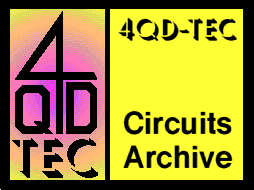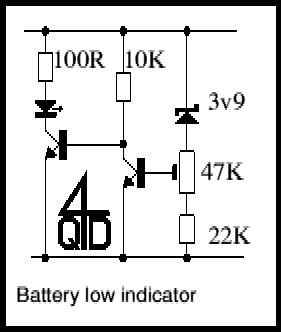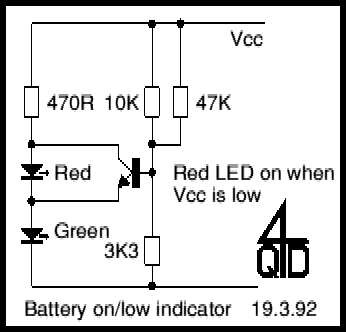

|
4QD-TEC
|
|
This is a page with a few circuits which may be useful for monitoring the state of your batteries.
Don't forget that 4QD manufacture an economy range of LED battery condition meters.
The circuit of these is freely available to 4QD-TEC members and, if there is demand we will also supply the circuit boards for members to construct. If there is a demand we can also supply these as a kit of parts.
The first simply circuit turns on an LED when the battery voltage gets too low.

For a transistor to conduct, it requires a voltage of about 0.6 between its base and emitter. This voltage is applied from the wiper of the 47K pot. Now if the pot is at minimum, this voltage is across the 22K, so the 47K will have about 1.28v across it - or 1.88 across the pair. Add the 3V9 from the zener: this will require a battery voltage of 5.78v to just turn on the first transistor.
Above 5.78 the right hand transistor is turned on, the left hand is therefore off and the LED is also off. Below 5.78v the LED will therefore come on.
With the pot at maximum, the 0.6v needed is developped across the 47K and 22K - so the threshold will be 3.9 + 0.6 or 4.5v. The preset will adjust between the two levels.
For other voltages you can simply change the zener diode. Or you could use a 10K resistor and a 100K pot. You will also need to increase the 100R resistor to keep the LED current sensible.
The second circuit shows a green LED if the battery is OK. This stays on all the time to indicate the battery is live and the red LED comes on when the battery voltage falls below the set threshold.

A green LED has around 2.0v on it when it is illuminated. This value varies a bit with different manufacturers, but is usually pretty well matched within any batch. Add the base emitter voltage and you need 2.6v on the base of right transistor (i.e. across the 3K3) to turn on the transistor. 2.6v across 3K3 needs 9.1 across the supply rail.
Below this threshold voltage the transistor is off and the RED LED is on. Above this voltage the red LED is off.
The threshold can be altered by altering the three resistors.
Some methods of fast recharging batteries require that the battery should be discharged to a specified voltage before re-charging. Here is a circuit for discharging.

The two transistors form a current source. R2 conducts via Zd and supplies base current to Tr2. Tr2's collector current flows through R1 developing a voltage which turns Tr1 on. As Tr1 starts to conduct it pinches current that would otherwise turn Tr2 harder on, so the circuit balances at the correct current to just develop 0.6v across R1.
So the current is 0.6/R1. You chose R1 for the correct discharge currrent. Remember that to discharge a 9v battery at 100mA, Tr2 will dissipate 9 x 0.1, or 900 milliwatts. Choose a suitable transistor with a suitable heatsink!
The current through R2 is defined by the battery voltage less the zener voltage so as the battery discharges, there will eventually come a voltage where the battery has fallen to the zener voltage (plus 0.6v across Tr2's base-emitter. The circuit is now completely off and the battery is discharged to the end level.
| 4QD Sites: |